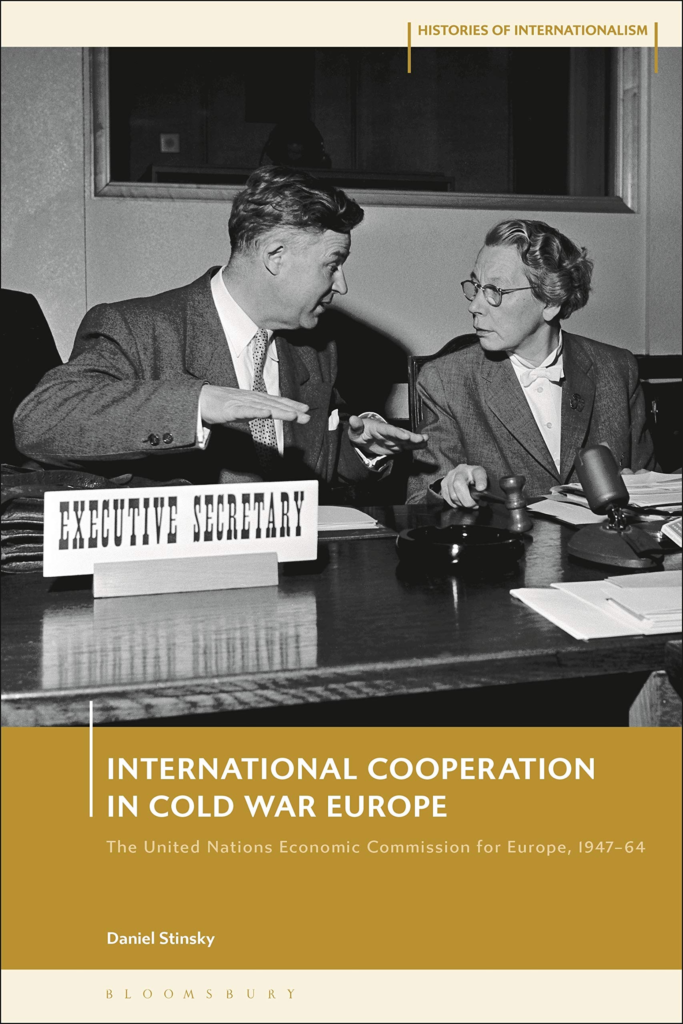
My new book explores the history of an unlikely international organization, the United Nations Economic Commission for Europe (UNECE), and its role in the Cold War and European integration.
Founded in 1947, UNECE was the first permanent international organization dedicated to economic cooperation in Europe. As a United Nations (UN) organization, UNECE linked the UN’s universalism to European regionalism. Both Cold War superpowers, the United States and the Soviet Union, were founding members. But while most Socialist member states boycotted its technical committees until the death of Stalin, Western governments set up a series of competitors. These alternative, more prominent organizations with overlapping membership and portfolios included the Marshall Plan organization OEEC and the first predecessors of today’s European Union (EU).
On this increasingly crowded stage of European economic organizations, UNECE was nonetheless able to carve out a niche for itself in East-West trade and technical cooperation, setting norms and standards that still have an impact today on the everyday lives of millions in Europe and beyond. Working against an overwhelming geopolitical trend, UNECE succeeded in bridging the Cold War divide in several instances and maintained a broad system of contacts across the Iron Curtain.
All-European Technocratic Internationalism
The ideas that shaped UNECE can be traced back to three locations during the interwar period and World War II: Geneva, where the League of Nations’ palace had become an unintended monument to the failure of interwar internationalism; Washington, DC, the world’s wartime planning capital; and Stockholm, where a European reaction against the continent’s looming geopolitical division took shape among exiles and intellectual elites. These three strands – the legacy of the League of Nations, the hands-on technocratic internationalism of WWII, and the rejection of the Cold War’s bipolar logic – later converged at UNECE, forming an organizational ideology that was internationalist, technocratic, and all-European.
UNECE and its predecessor organizations sought to tackle supply shortages on an all-European level and were important agents of European reconstruction. Yet, these efforts were soon thwarted by bloc formation. During UNECE’s early years, the emergence of a competing, Western European framework and an ensuing deadlock in East-West trade posed serious problems. Two distinct paths emerged for the future of economic cooperation in Europe: UNECE’s all-European path embedded in the UN system, and the Marshall Plan’s path of intra-mural, Western European cooperation.
With the two Cold War blocs solidifying, East-West trade became UNECE’s key problem. In 1945-47, European trade relied on a patchy network of bilateral barter arrangements. This inefficient system was overcome within Western Europe and among the Socialist economies but remained in place for trade between the blocs. Moreover, the reorientation of eastern European economies towards the Soviet Union and the US-led Western embargo then led to further decline. UNECE, the self-declared champion of East-West trade, struggled against this trend, initially without success.
East-West Trade and Economic Cooperation in Europe
Despite these grave initial setbacks, UNECE managed to find a niche in the system of international governance. Its role was defined by technical cooperation, East-West trade, and its relationship with European integration.
In the field of technical cooperation, UNECE’s work created tangible results. Technical agreements concluded at UNECE concerned e.g., the standardization of traffic signs or agricultural products. UNECE encouraged agreements between small groups of interested governments. Many of these agreements were later expanded to include more member states, with some eventually becoming global in scope. A considerable overlap in portfolios and membership existed with the Marshall Plan organization OEEC, leading to a complex relationship of competition and interdependence between the IOs. UNECE’s role as a technical agency rested on a comparatively independent secretariat with a strong research division, which was a constant source of tension between UN Headquarters and the European office in Geneva.
For East-West trade, the 1953 UNECE trade consultation marked an important turning point. Making use of conferencing techniques refined during previous, unsuccessful consultations, the meeting encouraged the conclusion of several new, bilateral trade agreements between Western and Socialist countries. Over the course of 1953-54, Socialist delegates returned to UNECE’s technical committees and stayed put, despite the rekindling of Cold War tension in the crises in Suez and Hungary in 1956. A breakdown of East-West relations as seen in 1948 did not reoccur in 1956. Contacts established on the work floor level remained intact. However, UNECE’s ensuing period of strength coincided with the re-emergence of the two German states as important players on the European scene. UNECE’s setup forbade an early and effective inclusion of either German state, showcasing the limits of its postwar representation of Europe.
UNECE’s history is closely interlinked with that of European integration. The European Coal and Steel Community (ECSC) was the first direct predecessor to today’s EU. Supranational institutions like the ECSC proved uniquely capable of capturing the sense of expectation connected with the buzzword of ‘European integration’. But ECSC emerged as part of an already existing system of European governance, one that included both UNECE and OEEC. The landscape of existing IOs adds an important, hitherto neglected layer to our understanding of the EU’s origins. The 1950s saw a further expansion of economic cooperation in Europe through a multitude of overlapping institutional frameworks. Through differentiation and specialization, these intersecting ‘integration circles’ managed to coexist.
Ultimately, the UN in general and important UNECE actors, like Gunnar Myrdal and Walt W. Rostow, redirected their attention away from Europe and towards the developing world. The Conference on Security and Cooperation in Europe (CSCE) took over the political mission of UNECE. Yet UNECE remained active in its niche as a technical agency and is today one of five UN regional commissions.
Daniel Stinsky received his PhD in European and Global History from Maastricht University in 2019. He has since entered the German diplomatic service and is currently posted at the Federal Foreign Office in Berlin. His book is part of the series Bloomsbury Histories of Internationalism and can be ordered here.